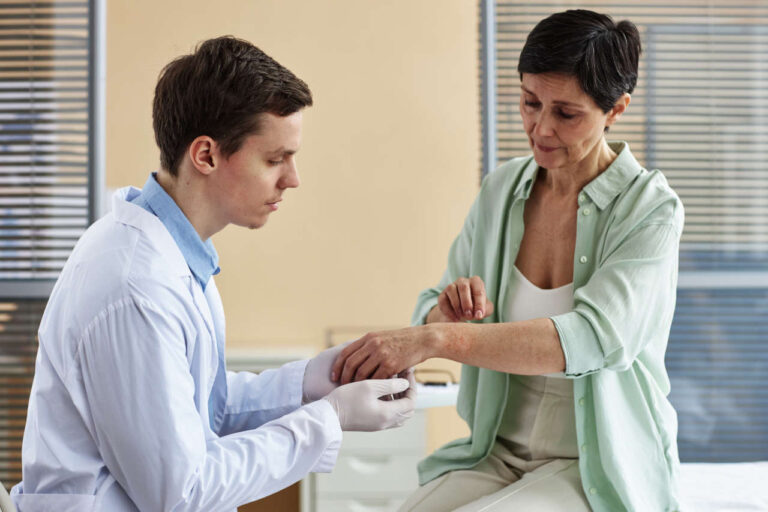
Toxic epidermal necrolysis (TEN) is a rare, life-threatening skin reaction. It is most commonly triggered by certain medications. However, in rare cases, it can be caused by infections or vaccinations.
Speak to a Specialist About Copay Assistance
A severe form of Steven-Johnson’s syndrome (SJS), TEN is diagnosed when you have large areas of blistering and peeling skin on more than 30% of your body. TEN also causes extensive damage to the moist linings (mucous membranes) in the mouth, nose, throat, eyes, and genitals.
In SJS, you have small areas of peeling skin, affecting less than 10% of your body. SJS-TEN overlap disease is when 10% to 30% of the body is affected.
How Common Is Toxic Epidermal Necrolysis?
TEN is a rare condition, affecting 1.9 people per million U.S. adults each year [1].
What Causes Toxic Epidermal Necrolysis?
In some cases, the exact cause is not known. In others, several factors can induce TEN, including:
- Antiseizure medications: Phenobarbital, phenytoin, carbamazepine, valproic acid, and lamotrigine
- Antibacterial drugs: Sulfonamides (trimethoprim-sulfamethoxazole), chloramphenicol, penicillins, and ciprofloxacin
- Non-steroidal anti-inflammatory drugs (NSAIDs): Piroxicam, meloxicam
- Antigout agents: Allopurinol
- Anti-HIV medications: Nevirapine and abacavir
Rare triggers can include:
- Bacterial infections: Mycoplasma pneumoniae infections
- Viral infections: Herpes and hepatitis A
- Vaccines: Meningococcal B and MMR vaccines
- Graft-versus-host disease
Risk Factors
The following factors can increase your risk of TEN:
- HIV infection
- Weak immune system (such as in HIV/AIDS and autoimmune disorders)
- Personal or family history of TEN
- Genetic factors
- Cancer (specifically blood cancers)
Symptoms

- Body aches
- Cough
- Fever
- Chills
- Headache
- Red and swollen eyes
As the disease progresses, you may have:
- Widespread skin pain
- A rapidly spreading rash affecting more than 30% of your body
- Blisters and peeling skin
- Sores and swelling on the mucous membranes, including the mouth, eyes, respiratory tract, and genitals
These signs and symptoms may resemble other skin diseases. Because TEN is life-threatening, seek immediate medical care if you think you have symptoms of TEN.
Toxic Epidermal Necrolysis Treatment
People with TEN need emergency care at a hospital, preferably in an intensive care unit (ICU) or burn center. Treatment is mainly supportive and includes [2]:
- Stopping all potential triggers
- Isolation to prevent infection
- Administering IV fluids and nutrition
- Protective dressings and antibacterial creams or ointments to prevent skin infection
- Antibiotic therapy if signs of infection are present
- Medications to reduce pain
- Eye and oral cavity examination
- Oxygen via a face mask (if needed)
- Medications to prevent blood clots
No specific treatment for TEN exists. However, your provider may consider the following based on your age, symptom severity, expectations, and preferences:
Intravenous Immunoglobulin (IVIG)
IVIG is a sterile liquid that contains disease-fighting proteins (immunoglobulins or antibodies). Some studies show that early treatment with high-dose IVIG can improve survival and speed recovery [3].
Systemic steroids
Your provider may give you a steroid to halt the progression of TEN. Nonetheless, the use of steroids is highly controversial. Some studies suggest that steroids may increase the risk of death.
IVIG With Steroids
According to a recent review published in the Journal of the American Academy of Dermatology, clinicians should consider combination therapy with IVIG and steroids to treat TEN [4]. The authors of the review conclude that this combination may reduce death risk in individuals with TEN.
Plasmapheresis (Plasma Exchange)
Plasmapheresis separates the liquid part of the blood (plasma) from blood cells. Following separation, the blood cells are mixed with a liquid and infused back into the body.
Daily plasmapheresis for 3 days can help remove the causative drug, its byproducts, and other inflammatory substances from the body.
Tumor Necrosis Factor-Alpha (TNF-Alpha) Inhibitors
TNF-alpha inhibitors, such as infliximab and etanercept, may help resolve skin lesions in toxic epidermal necrolysis. They may be used alone or as a second-line medication.
Can IVIG help? | Free IVIG Treatment Info
Toxic Epidermal Necrolysis Survival Rate
Toxic epidermal necrolysis causes death in about 25% of the cases, and the death rate is lower in children (less than 10%). The death rate is higher if you [5, 6]:
- Are over 40
- Have high blood sugar
- Have a fast heart rate
- Have chronic kidney disease
Complications
People older than 70 years are most likely to develop complications. Likewise, the risk of complications is higher in people with liver cirrhosis (scarring of the liver) or cancer.
Complications of TEN include:
Sepsis
Sepsis or blood infection is a life-threatening condition. It happens when the immune response to an infection damages your body’s vital organs, putting you into shock and causing organ failure.
Breathing Problems
If your lungs are involved, you may find it difficult to breathe. In severe cases, your lungs may be too weak, causing an excess of carbon dioxide and a deficiency of oxygen in your blood.
Eye Problems
Eye problems associated with TEN are dry eye, ingrown eyelashes, corneal scarring, and, in rare cases, blindness.
Toxic Epidermal Necrolysis Long-Term Effects
Some long-term effects among TEN survivors are:
- Dry itchy skin
- Hair or nail loss
- Excessive sweating
- Dry eyes
- Sensitivity to light
- Dry mouth
- Lung damage
In a recent survey of 121 TEN/SJS survivors, more than half screened positive for depression, and over 40% screened positive for anxiety [7].
Get Financial Assistance
Toxic Epidermal Necrolysis (TEN) vs Steven-Johnson’s Syndrome (SJS)
The major differences between TEN and SJS are as follows:
|
Features |
TEN |
SJS |
|
Severity |
More severe |
Less severe |
|
Affected body surface |
More than 30% |
Less than 10% |
|
Occurrence in the US |
1.9 per million people each year |
9.3 per million people each year |
|
Death rate |
About 25% in adults |
About 10% |
Frequently Asked Questions
Which drug causes toxic epidermal necrolysis?
Medications commonly associated with toxic epidermal necrolysis are:
- Antiseizure medications: Phenobarbital, phenytoin, carbamazepine, valproic acid, and lamotrigine
- Antibacterial drugs: Sulfonamides (trimethoprim-sulfamethoxazole), chloramphenicol, penicillins, and ciprofloxacin
What causes epidermal necrolysis?
Medications are the primary causes of TEN in adults, whereas infections are the main causes in children.
Which layer of skin is affected by toxic epidermal necrolysis?
Toxic epidermal necrolysis causes the top layer of your skin (epidermis) to detach from the lower layers of skin (dermis).
What are the clinical features of toxic epidermal necrolysis?
TEN causes peeling skin on more than 30% of your body. It also causes extensive damage to the moist linings (mucous membranes) in the mouth, nose, throat, eyes, and genitals.
REFERENCES:
- Labib A, Milroy C. Toxic Epidermal Necrolysis. [Updated 2023 May 8]. In: StatPearls [Internet]. Treasure Island (FL): StatPearls Publishing; 2024 Jan-. Available from: https://www.ncbi.nlm.nih.gov/books/NBK574530/#
- Seminario-Vidal, Lucia et al. “Society of Dermatology Hospitalists supportive care guidelines for the management of Stevens-Johnson syndrome/toxic epidermal necrolysis in adults.” Journal of the American Academy of Dermatology vol. 82,6 (2020): 1553-1567. doi:10.1016/j.jaad.2020.02.066
- Momin, Saira B. “Review of intravenous immunoglobulin in the treatment of stevens-johnson syndrome and toxic epidermal necrolysis.” The Journal of clinical and aesthetic dermatology vol. 2,2 (2009): 51-8.
- Tsai, Tsung-Yu et al. “Treating toxic epidermal necrolysis with systemic immunomodulating therapies: A systematic review and network meta-analysis.” Journal of the American Academy of Dermatology vol. 84,2 (2021): 390-397. doi:10.1016/j.jaad.2020.08.122
- Benedetti, Julia. “Stevens-Johnson Syndrome (SJS) and Toxic Epidermal Necrolysis (TEN).” MSD Manual Consumer Version, 16 Feb. 2024, www.msdmanuals.com/home/skin-disorders/hypersensitivity-and-reactive-skin-disorders/stevens-johnson-syndrome-sjs-and-toxic-epidermal-necrolysis-ten.
- Wasuwanich, Paul et al. “Epidemiology of Stevens-Johnson syndrome and toxic epidermal necrolysis in the United States and factors predictive of outcome.” JAAD international vol. 13 17-25. 11 Jul. 2023, doi:10.1016/j.jdin.2023.06.014
- Hoffman, Melissa et al. “Long-term Physical and Psychological Outcomes of Stevens-Johnson Syndrome/Toxic Epidermal Necrolysis.” JAMA dermatology vol. 157,6 (2021): 712-715. doi:10.1001/jamadermatol.2021.1136













